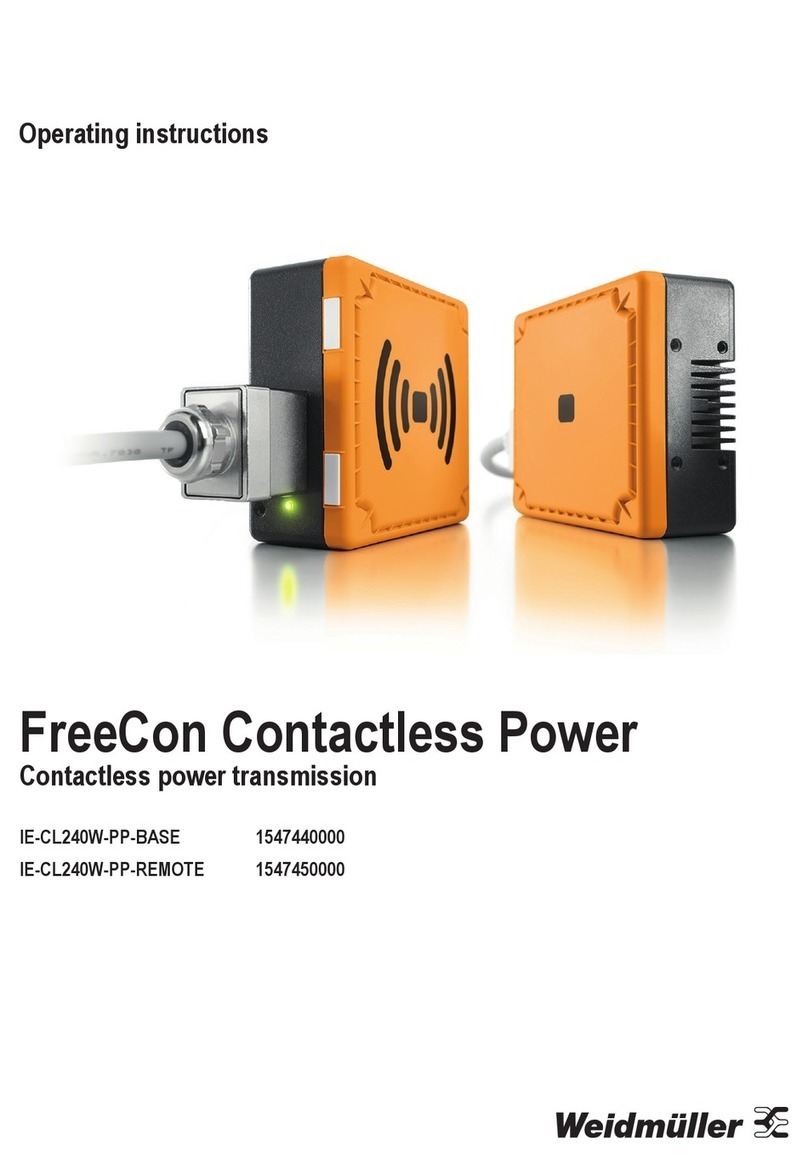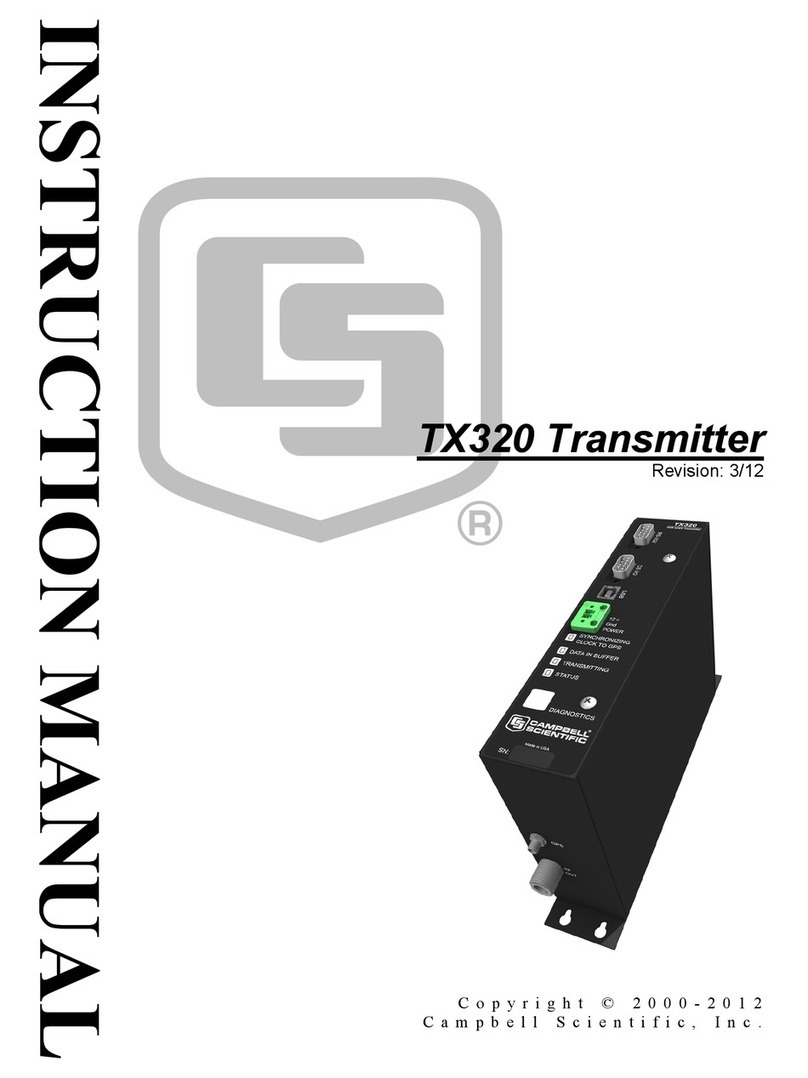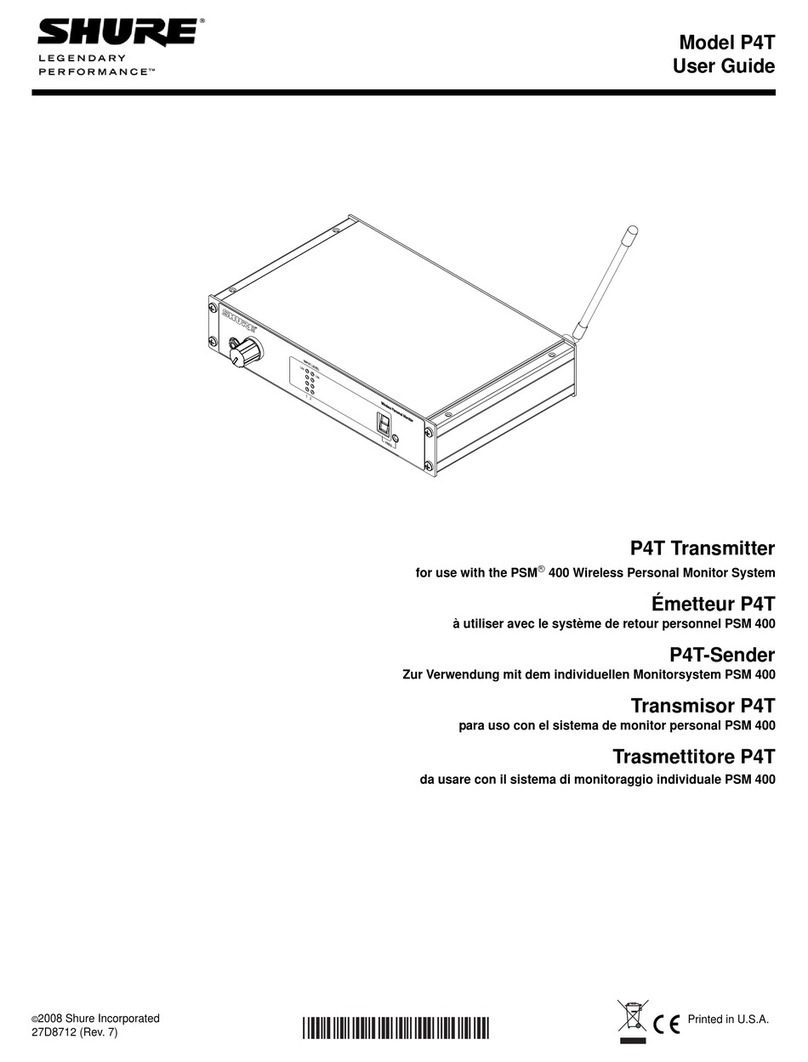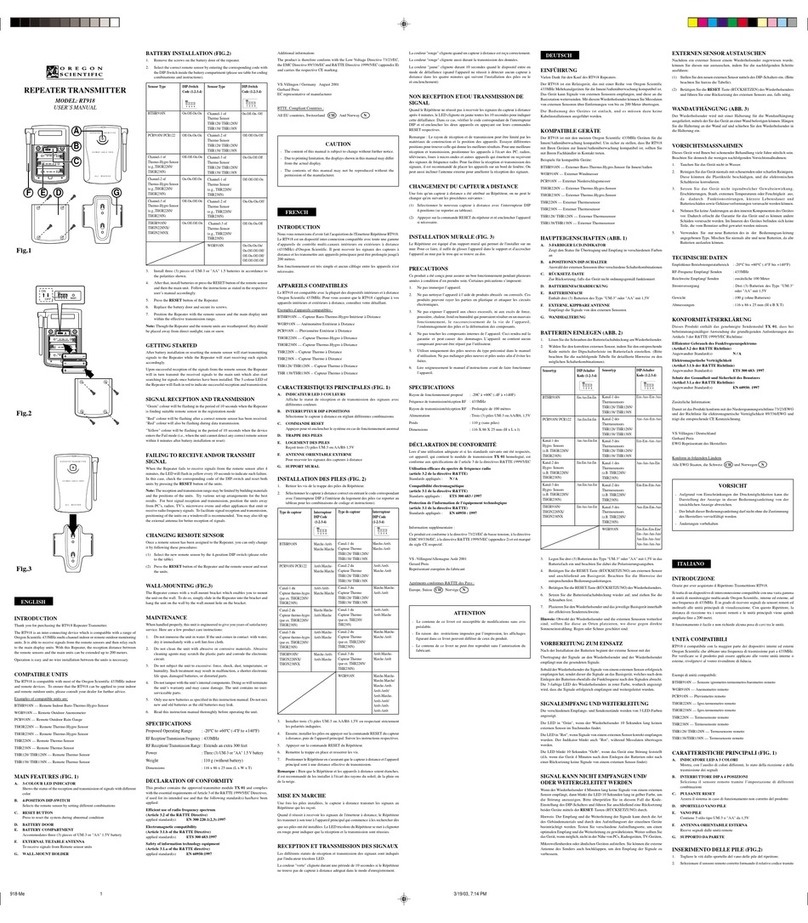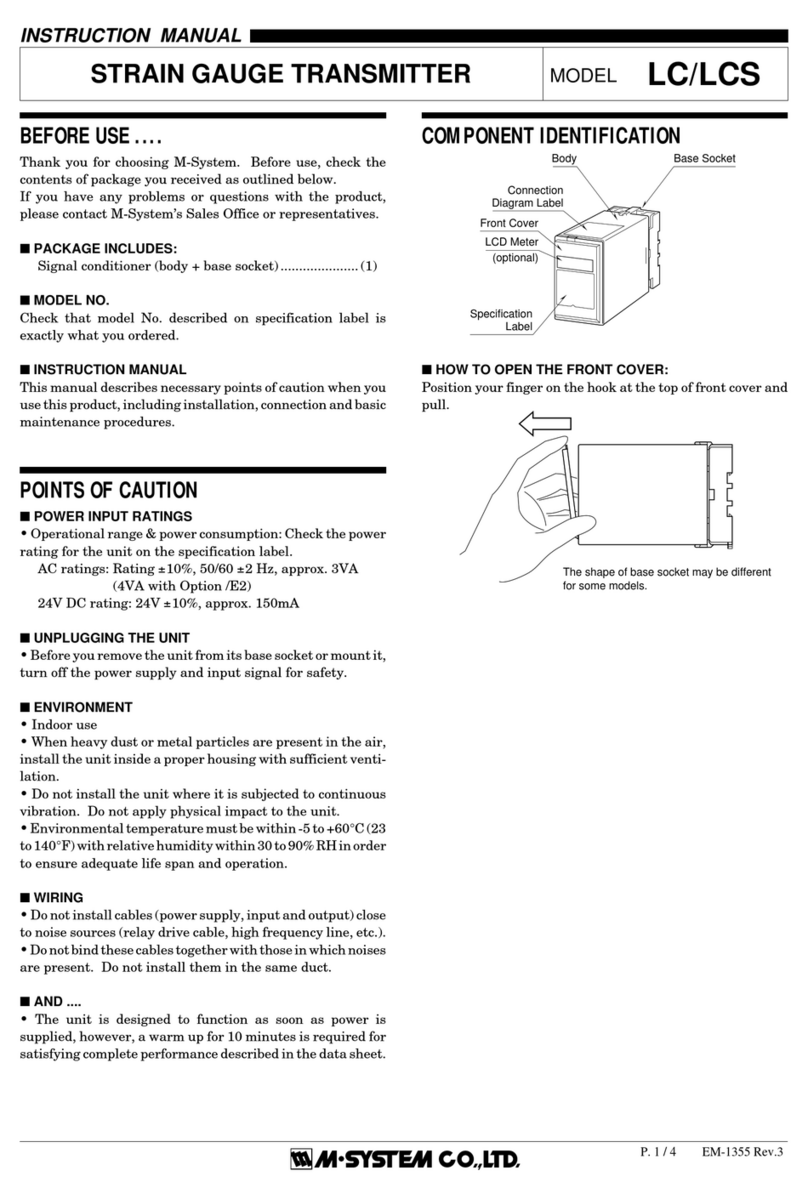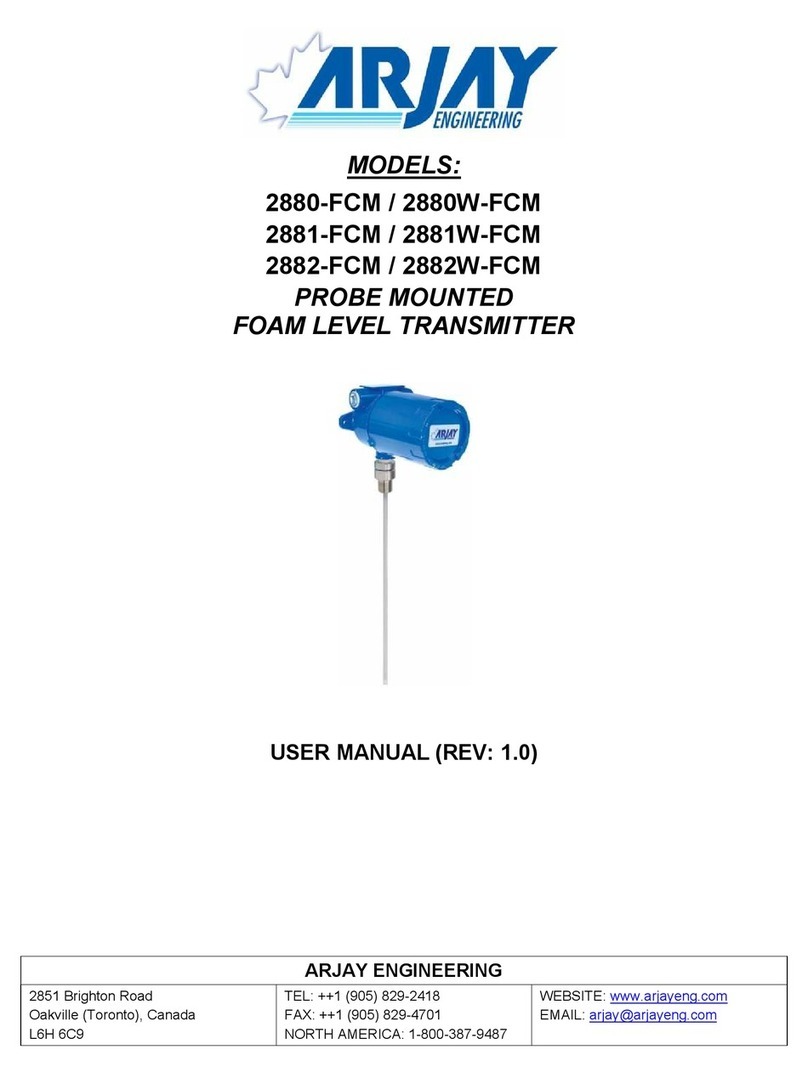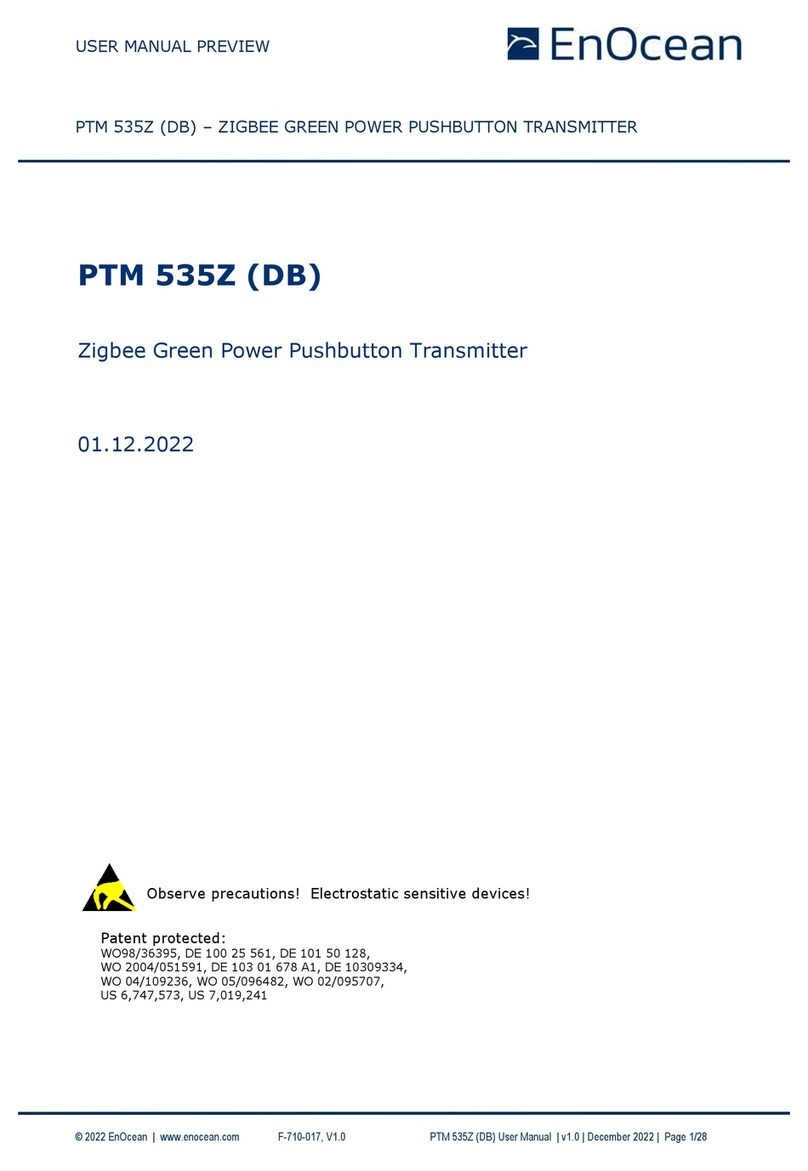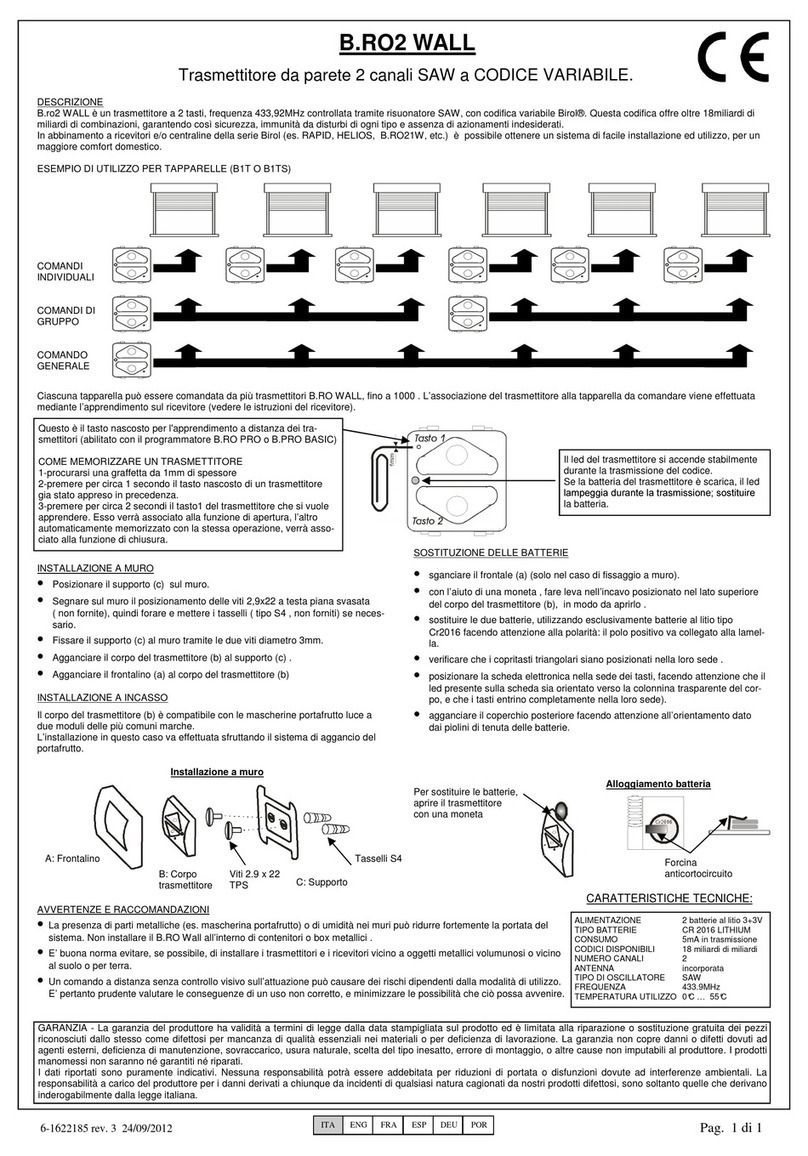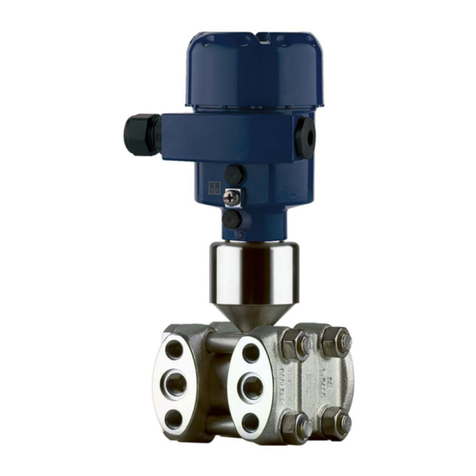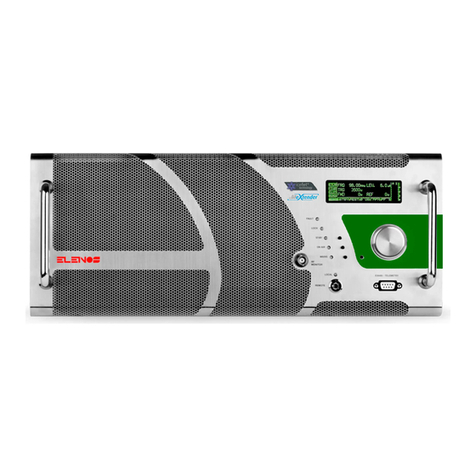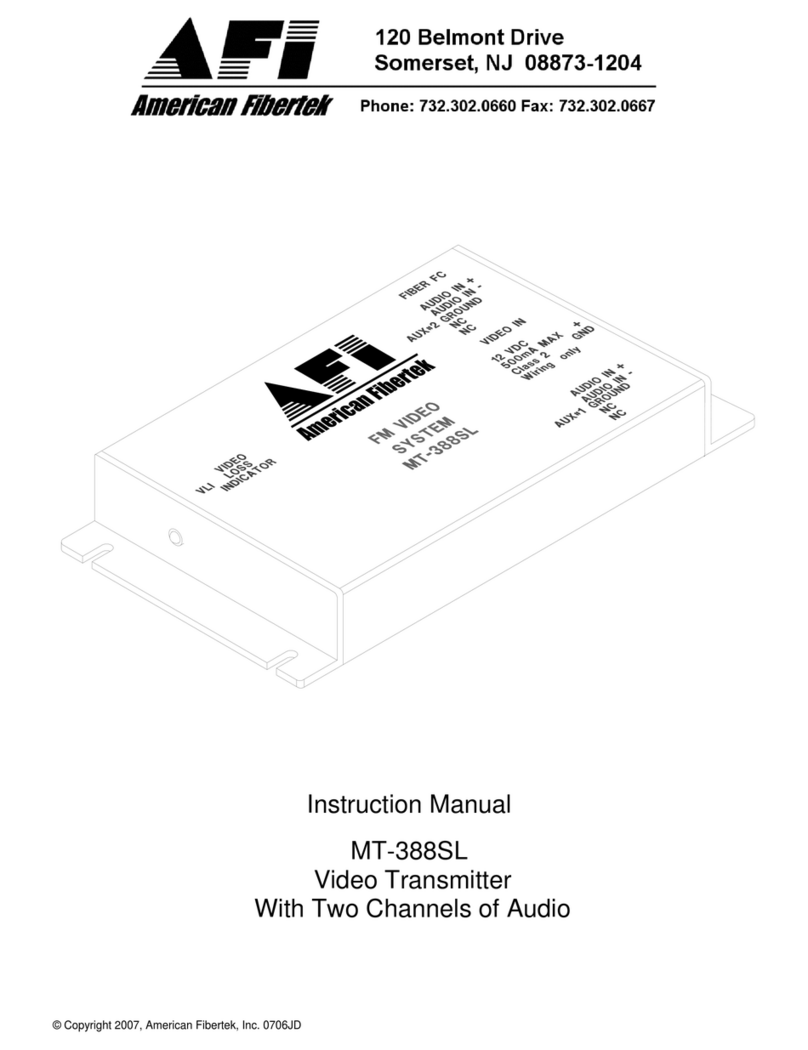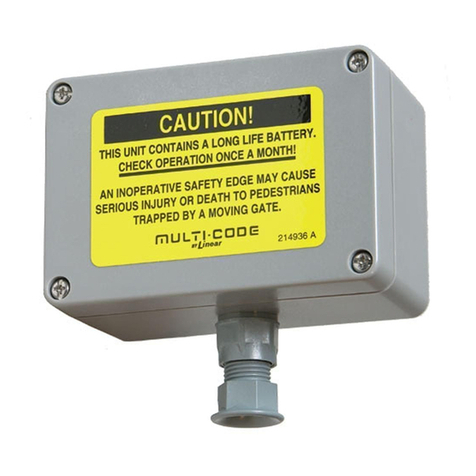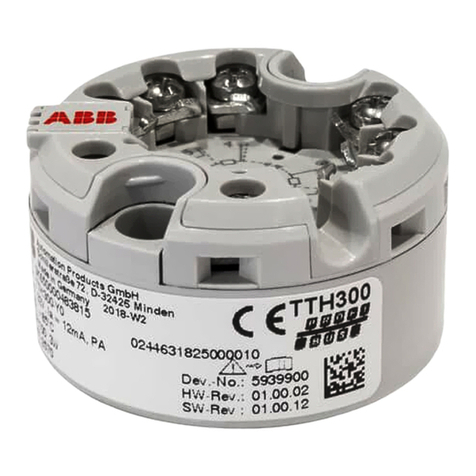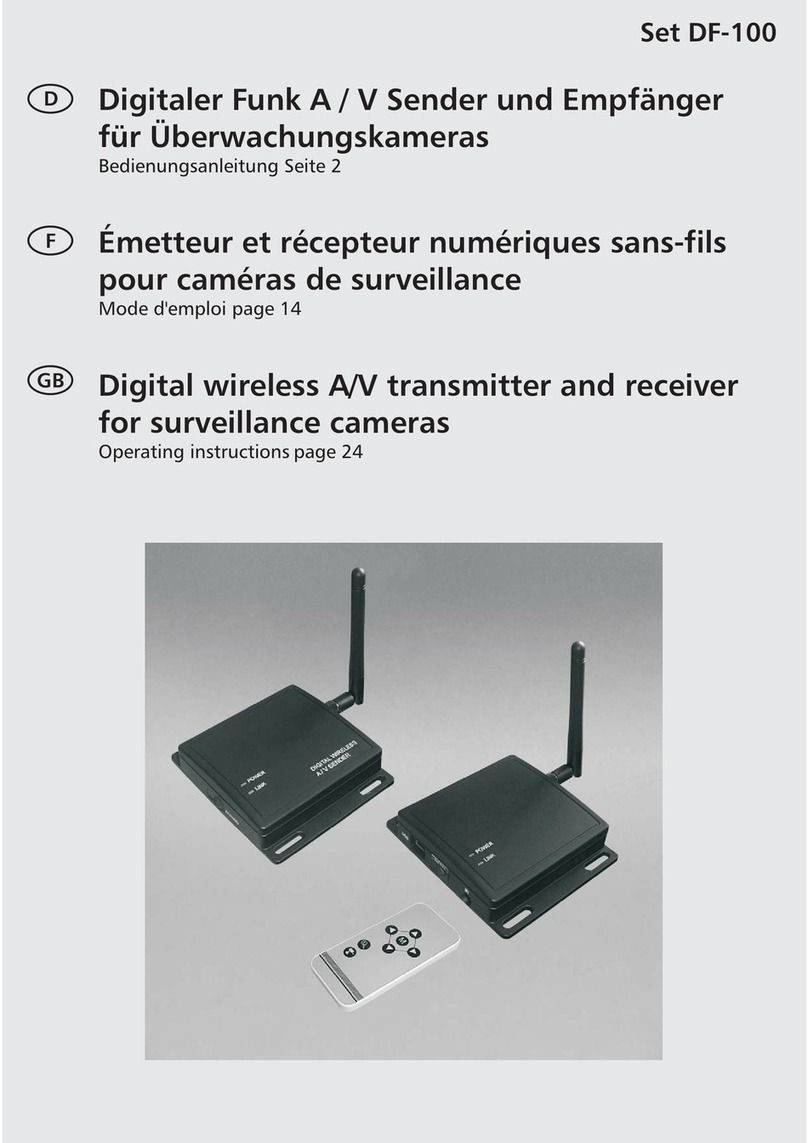Great Lakes Instruments 692P User manual

Manual No. 692P
Revision 9-898
MODEL 692P
TWO-WIRE
pH TRANSMITTER

Rev. 9-898 Model 692P
-1-
INSTRUMENT SETUP GUIDE
This manual contains detailed instructions for all operating aspects of this instrument.
Read Part One for a general description of the Model 692P. Part Two explains how to
install and wire the instrument. To familiarize yourself with the basic operation of the
692P, read Part Three, Sections 1, 2 and 3. For instrument startup, perform the setup
steps in Section 4. The following guide shows you the appropriate Section 5 and 6 sub-
sections to use for temperature and pH calibration when using a GLI 5-wire Differential
Technique sensor or a conventional pH combination electrode.
Single-Point
Temperature
Calibration
Two-Point
Temperature
Calibration
Section 5.3
(starton pg.30)
SingleOrTwo-Point
Method
Section 6.2or6.3
(starton pg.32)
Two-Point Or
Table Method
Section 6.4or6.5
(starton pg.34)
Output Setup
Section 5.2
(starton pg.30)
Section 7(starton pg.40)
Using Security
Lock Feature
Section 8(starton pg.42)
300 Ohm
ThermistorFixed
Resistor
1000 Ohm
RTD
Whattype oftemperature
compensation isused?
SingleOrTwo-Point
TemperatueCalibration*
Section 5.2or5.3
(starton pg.30)
Combination Electrode
Conventional
"Two-key"
Temperaturecalibrationis
onlynecessarywhen
extremelyaccurate
measurementisrequired.
*
WhichpHcalibration method
do you intend touse?
Whichtype ofsensorareyou
using withthistransmitter?
5-Wire Sensor

Model 692P Rev. 9-898
-2-

Rev. 9-898 Model 692P
-3-
TABLE OF CONTENTS
PART ONE - INTRODUCTION
SECTION 1 GENERAL INFORMATION
1.1 Instrument Capability:
Input Versatility ........................................................ 7
Display Readouts.....................................................7
Operator Interface....................................................7
Output Flexibility ......................................................7
Operator Safety........................................................7
1.2 Battery Backup..........................................................7-8
1.3 Product Identification ................................................... 8
SECTION 2 SPECIFICATIONS................................................................9
PART TWO - INSTALLATION
SECTION 1 UNPACKING......................................................................10
SECTION 2 MECHANICAL REQUIREMENTS
2.1 Location......................................................................10
2.2 Mounting ...............................................................10-12
2.3 Plugging Conduit Holes .............................................12
SECTION 3 ELECTRICAL CONNECTIONS
3.1 GLI 5-Wire Differential Technique Sensor.................12
3.2 Conventional Combination Electrode:
Direct Hookup (distances less than 10 feet) .....13-14
Indirect Hookup with Model 714 Preamp
(distances more than 10 feet) ............................15
3.3 Power Supply.............................................................15
3.4 Analog Output.......................................................15-17
3.5 Hazardous Area Wiring.........................................17-18
PART THREE - OPERATION
SECTION 1 OPERATING CONTROLS
1.1 Keypad Switches...................................................19-22
`1.2 Slide Switches.......................................................22-23
1.3 Program Jumper.........................................................24
1.4 Status Indicators ........................................................25
SECTION 2 MEASURED VARIABLES..................................................25

Model 692P Rev. 9-898
-4-
TABLE OF CONTENTS (continued)
SECTION 3 SETUP VARIABLES
3.1 Calling Up Setup Variables........................................ 26
3.2 Entering Values.......................................................... 26
3.3 Setup Variables Call-Up Chart and
Table of Descriptions........................................26-29
SECTION 4 INSTRUMENT STARTUP
4.1 Checking Battery Backup Jumper.............................. 29
4.2 Setting Sensor Input Type:
GLI 5-Wire Differential Technique Sensor.............29
Conventional Combination Electrode................29-30
4.3 Selecting Temperature Display Units (°C or °F) ........30
4.4 Understanding Calibration .........................................30
4.5 Selecting Default State for Out-of-Range Condition..30
SECTION 5 TEMPERATURE CALIBRATION
5.1 Temperature Effects on pH Reading:
300 Ohm Thermistor Compensation ...................... 30
1000 Ohm RTD Compensation..............................30
Fixed Resistor Compensation................................31
5.2 Single-Point Method................................................... 31
5.3 Two-Point Method.................................................31-32
SECTION 6 pH CALIBRATION
6.1 Summary of Methods ............................................32-33
6.2 Conventional Single-Point Method........................33-34
6.3 Conventional Two-Point Method...........................34-35
6.4 “Two-Key” Two-Point Method:
Selecting This Method.......................................35-36
Entering Calibration Points
(by qualified person) ..........................................36
Performing Calibration ......................................36-38
6.5 “Two-Key” Table Method:
Selecting This Method.......................................38-39
Entering Calibration Points
(by qualified person) .....................................39-40
Performing Calibration ......................................40-41
SECTION 7 OUTPUT SETUP
7.1 Using Range Expand Feature:
Setting Low Endpoint........................................41-42
Setting High Endpoint .......................................42-43
7.2 Using Output Hold Feature ........................................ 43
SECTION 8 USING SECURITY LOCK FEATURE
8.1 Locking Stored Values............................................... 43
8.2 Unlocking Stored Values............................................ 44

Rev. 9-898 Model 692P
-5-
TABLE OF CONTENTS (continued)
PART FOUR - OPERATING AIDS
SECTION 1 PRESERVING MEASUREMENT ACCURACY
1.1 Keeping Sensor Clean............................................... 45
1.2 Keeping Instrument Calibrated................................... 45
1.3 Checking Sensor Slope.............................................. 45
1.4 Avoiding Ground Loop Errors.....................................45
1.5 Avoiding Electrical Interference .................................45
1.6 Checking Buffers for “Two-Key”
Table Method of pH Calibration........................45-46
SECTION 2 mV CALIBRATION
2.1 Single-Point Method................................................... 47
2.2 Two-Point Method.................................................47-48
SECTION 3 SIMULATING MEASURED VALUES................................. 49
PART FIVE - PRINCIPLE OF OPERATION
.....................................................................................50-51
PART SIX - SERVICE AND MAINTENANCE
SECTION 1 GENERAL
1.1 Inspecting Sensor Cable............................................52
1.2 Checking System Periodically....................................52
SECTION 2 TROUBLESHOOTING
2.1 System Diagnostic Error Messages...........................52
2.2 Resetting Instrument to Factory-Default Values ........53
2.3 Isolating the Problem:
Checking Electrical Connections ...........................53
Checking Instrument .........................................54-55
2.4 Customer Assistance ............................................55-56
PART SEVEN - SPARE PARTS AND ACCESSORIES
..........................................................................................57

Model 692P Rev. 9-898
-6-
TABLE OF CONTENTS (continued)
ILLUSTRATIONS: Figure 2-1 Enclosure Outline...........................................11
Figure 2-2 Mounting Configurations................................12
Figure 2-3 Connection Details for Combination
Electrode with Coaxial Cable......................... 13
Figure 2-4 Connection Details for Combination
Electrode with Triaxial Cable .........................13
Figure 3-1 Keypad Switches............................................ 20
Figure 3-2 Controls on Backside of Display
Module Assembly and Electrical
Hookup Details............................................... 24
Figure 3-3 Display Modes and Call-up Chart
of Setup Variables.......................................... 27
Figure 5-1 Instrument Operations Block Diagram ...........50
TABLES: Table A Resistor Values for Fixed
Temperature Compensation........................... 14
Table B Description of pH Setup Variables................. 28
Table C Description of Temperature
Setup Variables........................................... 28
Table D Description of mV Setup Variables ................29
Table E Buffer Values for “Two-Key” Table Method.... 39
Table F System Diagnostic Error
Messages/Meanings ......................................52
Table G Troubleshooting Common Problems.............. 55

PART ONE - INTRODUCTION SECTION 1 - GENERAL INFORMATION
Rev. 9-898 Model 692P
-7-
PART ONE - INTRODUCTION
SECTION 1 - GENERAL INFORMATION
1.1 Instrument Capability
Input Versatility
Display Readouts
Operator Interface
Output Flexibility
Operator Safety
1.2 Battery Backup
The instrument may be used with any GLI Differential Tech-
nique pH sensor that has an integral preamplifier (identified
by its 5-wire cable) or a conventional pH combination elec-
trode with integral or separate temperature sensor. A switch
sets the Model 692 for use with a 300 ohm thermistor or
1000 ohm RTD temperature sensor input to compensate the
pH measurement for variations in temperature.
The large liquid crystal display can alternately indicate four
variables: pH, temperature (in °C or °F), the sensor's mV
signal, or the 4-20 mA instrument output.
Abbreviated identifiers are shown along with their related
numerical values to provide understandable readouts for
instrument setup, calibration and process monitoring. Pro-
cedure messages prompt the operator during instrument
setup and calibration. System diagnostic error messages
flash whenever the instrument detects an out-of-range input
for pH and/or temperature or a memory loss.
The 4-20 mA instrument output, which tracks the measured
pH, is isolated to eliminate problems caused by ground
loops. An output hold feature can be used to maintain the
latest output during calibration or instrument setup to sus-
pend operation of a receiving device. A range expand
feature allows the 4-20 mA output to represent a one pH
unit or larger segment of the measuring scale.
Modular construction simplifies field servicing and provides
electrical safety for the operator. The printed circuit module
assemblies contain voltages no greater than 24 VDC and
are safe to handle. A terminal strip compartment, with sepa-
rate access and weatherproof seals, permits electrical
hookup without exposing the instrument circuitry to the envi-
ronment.
A lithium battery on the backside of the display board re-
tains all user-entered setup values for approximately one
year (at 25°C), when loop power is removed. The battery's
capacity is one year of backup time which can occur over a

PART ONE - INTRODUCTION SECTION 1 - GENERAL INFORMATION
Model 692P Rev. 9-898
-8-
1.3 Product Identification
period of up to 10 years. A BATTERY ON/OFF jumper is
located next to the battery to disconnect the battery when
the instrument is not used for an extended time.
NOTE: If the instrument is operated with the battery
switched off, user-entered values are stored only as
long as power is applied. When power is removed,
all stored values will be lost. Factory-set defaults
will replace all user-entered values when power is
re-applied.
The back-up battery is replaceable.
WARNING: FOR HAZARDOUS AREA APPLICATIONS,
THE 692 TRANSMITTER MUST BE MOVED TO A SAFE
AREA FOR BATTERY REPLACEMENT, IF NEEDED.
The serial number of your instrument is located at the top of
the backside of the display module assembly (Figure 3-2).
Write the serial number in the space provided below for
convenient identification should technical assistance be re-
quired.
Serial Number

PART ONE - INTRODUCTION SECTION 2 - SPECIFICATIONS
Rev. 9-898 Model 692P
-9-
SECTION 2 - SPECIFICATIONS
2.1 Operational
2.2 Analyzer Performance
(Electrical, Analog
Output)
2.3 Mechanical
Display .........................4-1/2 digit LCD with measurement unit and
setup variable identifiers, 7/8" high digits
Measuring Range:
pH............................0.00 to 14.00 pH
mV...........................(-)500 to (+)500 millivolts
Temperature............(-)10.0 to (+)110.0°C (14 to 230°F)
Ambient Conditions ......-30 to 50°C (-22 to 122°F), 0 to 95% relative
humidity, non-condensing
Temperature
Compensation ..............Automatic, 0-100°C (32-212°F), 300 ohm ther-
mistor or Pt 1000 RTD, switch selectable
Sensor-to-Transmitter
Distance .......................3000 feet maximum for GLI 5-Wire Differential
Technique sensor; 10 feet maximum for direct
connection of combination electrode (a GLI
Model 714 preamp is required for distances
greater than 10 feet)
Power Requirements ....16 to 40 volts DC
Analog Output ..............Isolated 4-20 mA with output hold feature
Range Expand - The 4-20 mA output can be made to represent a
one pH unit or larger segment of the measuring scale.
Hazardous Area
Classification:
Intrinsic Safety.......UL and CSA: Class I, Div. 1 Groups A, B, C, & D
Class II, Div. 1 Groups E, F, & G
Baseefa: Zones 0 and 1, Groups IIC through IIA
Division 2............... CSA:Class I, Div. 2 Groups A, B, C, and D
Class II, Div. 2 Groups E, F, and G
♦Maximum Loop Load
(in series with 692P
and power supply).......With 24 VDC supply: 400 ohms
With 32 VDC supply: 800 ohms
With 40 VDC supply: 1200 ohms
NOTE - For long cable runs, the resistance of the wire must be
considered and may decrease maximum load capability.
♦Not applicable when using barrier for intrinsic safety.
Sensitivity.....................0.05% of span
Stability ........................0.05% of span per 24 hours, non-cumulative
Non-linearity.................0.05% of span
Repeatability.................0.01% of span or better
Temperature Drift.........Zero and Span: 0.01% of span per °C
Response Time ............1 second to 90% of value upon step change
Enclosure .....................General purposesafe for Division 2; NEMA
4X, polycarbonate with two 1/2-inch conduit
holes and four stainless steel mounting tabs
Mounting
Configurations ..............Surface mount, optional vertical or horizontal
pipe mounting
Net Weight ...................3 lbs. (1.36 kg) approx.

PART TWO - INSTALLATION SECTION 1 - UNPACKING
Model 692P Rev. 9-898
-10-
PART TWO - INSTALLATION
SECTION 1 - UNPACKING
After unpacking, it is recommended to save the shipping
carton and packing materials in case the instrument is
stored or re-shipped. Inspect the equipment and carton for
damage. If there is evidence of shipping damage, notify the
carrier immediately.
SECTION 2 - MECHANICAL REQUIREMENTS
2.1 Location
2.2 Mounting
An agency approved Model 692 is designed intrinsically
safe. That is, an explosionproof enclosure is not required
when the transmitter, powered through an approved barrier,
is located in Division 1 hazardous areas.
WARNING: THE POWER SUPPLY AND INTRINSIC
SAFETY BARRIER MUST ALWAYS BE LOCATED IN A
SAFE AREA.
1. Locate the 692 within 3000 feet of where the GLI 5-wire
Differential Technique sensor is to be installed. If a
combination electrode is used, the 692 must be within
10 feet of the electrode for a direct cable run. A GLI
Model 714 preamp may be used to extend this distance
to 3000 feet, but the preamp must be within 10 feet of
the electrode.
2. Mount the 692 in a location that is:
nClean and dry where little or no vibration exists.
nProtected from falling corrosive fluids.
nWithin ambient temperature limits (-22 to 122°F,
-30 to 50°C).
CAUTION: MOUNTING IN DIRECT SUNLIGHT MAY
INCREASE TEMPERATURE ABOVE MAX. LIMIT.
Refer to Figure 2-1 for enclosure and mounting dimension
details. Figure 2-2 illustrates various mounting configura-
tions. Use the four stainless steel tabs to surface-mount the
instrument. An optional hardware kit is required for pipe-

PART TWO - INSTALLATION SECTION 2- MECHANICAL REQUIREMENTS
Rev. 9-898 Model 692P
-11-
mounting. The bracket attachment method determines verti-
cal or horizontal pipe mounting configuration.
To surface mount the Model 692:
1. Place tabs in appropriate locations on back of enclosure
and fasten with screws provided.
2. Position instrument on flat surface and use appropriate
fasteners to secure it in place.
FIGURE 2-1 Enclosure Outline

PART TWO - INSTALLATION SECTION 3 - ELECTRICAL CONNECTIONS
Model 692P Rev. 9-898
-12-
FIGURE 2-2 Mounting Configurations
2.3 Plugging Conduit
Holes Use conduit hubs or cable feed-thru fittings where cables
enter the enclosure. Holes not used for cable entry should
be sealed with plugs.
NOTE: Use NEMA 4 rated fittings and plugs to maintain the
watertight integrity of the NEMA 4 enclosure.
SECTION 3 - ELECTRICAL CONNECTIONS
3.1 GLI 5-Wire Differential
Technique Sensor
To access terminal strips for electrical connections, loosen
bottom four captive fasteners and remove terminal com-
partment cover. Figure 3-2 shows terminal designations for
instrument hookup. If the transmitter is located in a hazard-
ous area, refer to Section 3.5 for wiring details.
NOTE: For a CE-approved Model 692, the system must be
wired in accordance with GLI hookup drawing
1001X4N1306.
It is recommended that sensor signal wires be run in 1/2"
metal conduit for protection against moisture and mechani-
cal damage. Do not run signal wires in same conduit with
power or control wiring (“electrical noise” may interfere with
sensor signal).
1. Place SWITCH 3 on back of display module assembly
(Figure 3-2) in DIFF. (off/right) position and TEMP.
COMP. switch to THERM.
2. Connect sensor (or interconnect cable) wires to
DIFFERENTIAL SENSOR terminals on TB2 (Figure 3-
2), matching colors as indicated.

PART TWO - INSTALLATION SECTION 3 - ELECTRICAL CONNECTIONS
Rev. 9-898 Model 692P
-13-
3.2 Conventional
Combination Electrode
Direct Hookup
(distances less
than 10 feet)
1. Place SWITCH 3 on back of display module assembly
(Figure 3-2) in COMB. (on/left) position.
2. Active Electrode
Connect active electrode (center wire in coaxial or triax-
ial cable) to TB5 (ACTIVE) terminal post.
3. Reference Electrode
For a combination electrode that has a coaxial cable,
clamp the braided shield (reference electrode wire) un-
der TB4 (REF.) terminal as shown in Figure 2-3.
If the electrode has a triaxial cable, clamp the inner
braided shield (reference electrode wire) under TB4
(REF.) terminal as shown in Figure 2-4.
FIGURE 2-3 FIGURE 2-4
Connection Details for Connection Details for
Combination Electrode Combination Electrode
with Coaxial Cable with Triaxial Cable
4. Temperature Compensation Wiring
A. Automatic with Integral Temperature Sensor
1. The integral temperature sensor must be a 300
ohm thermistor or 1000 ohm RTD. Depending
which type of sensor it is, set TEMP.COMP.
switch to THERM. or RTD. position respectively.

PART TWO - INSTALLATION SECTION 3 - ELECTRICAL CONNECTIONS
Model 692P Rev. 9-898
-14-
2. For a combination electrode that has a coaxial
cable, connect separate temperature sensor wires
to TEMP COMP terminals on TB6 (Fig. 3-2).
If the electrode has a triaxial cable, clamp the
outer braided shield (temperature sensor wire)
under TB3 (RTD) terminal as shown in Figure 2-
4. In this case, set TEMP.COMP. switch to RTD.
position.
B. Automatic with Separate Temperature Sensor
1. The separate temperature sensor must be a 300
ohm thermistor or 1000 ohm RTD. Depending on
which type of sensor it is, set TEMP.COMP.
switch to THERM. or RTD. position respectively.
2. Connect separate temperature sensor (GLI p/n
60A2A9860-series) wires to TEMP COMP termi-
nals on TB6 (Figure 3-2).
C. Fixed with External Resistor
1. Set TEMP.COMP. switch to THERM. position.
2. Connect the specific value resistor which corre-
sponds with the desired temperature compensa-
tion across TEMP COMP terminals on TB6 (Fig.
3-2). The following table provides specific resistor
values required for the listed fixed temperature
compensation.
Table A RESISTOR VALUES FOR FIXED
TEMPERATURE COMPENSATION
°CResistor Value
(in ohms) °CResistor Value
(in ohms)
0 771 55 114
5 631 60 99
10 519 65 85
15 430 70 74
20 358 75 65
25 300 80 57
30 252 85 50
35 213 90 44
40 181 95 39
45 155 100 35
50 133

PART TWO - INSTALLATION SECTION 3 - ELECTRICAL CONNECTIONS
Rev. 9-898 Model 692P
-15-
Indirect Hookup
with Model 714 Preamp
(distances more
than 10 feet)
3.3 Power Supply
3.4 Analog Output
1. Place SWITCH 3 on back of display module assembly
(Figure 3-2) in DIFF. (off/right) position and TEMP.
COMP. switch to THERM.
2. Locate the GLI Model 714 preamp within 10 feet of the
combination electrode. Refer to the Model 714 preamp
instruction manual for electrical connection details be-
tween the combination electrode and the preamp.
3. The Model 692 can be located up to 3000 feet from the
Model 714 preamp. Connect interconnect cable from the
preamp to the Model 692 DIFFERENTIAL SENSOR ter-
minals on TB2 (Figure 3-2), matching colors as
indicated.
Connect the DC voltage power supply to “4-20 mA” termi-
nals on TB1, matching polarity as indicated.
NOTE: If the 692 is used in an intrinsically safe application,
it may be located in a Class I or II, Division 1 haz-
ardous area without an explosionproof enclosure
when powered through an approved barrier. Refer
to Section 3.5 for details on hazardous area wiring
requirements.
The isolated 4-20 mA output can represent either the
measuring scale or a selected segment of it. To use the
range expand feature, refer to Part Three, Section 7.1 for
details.
The isolated 4-20 mA output can drive auxiliary devices (re-
sistive loads) such as displays, recorders and computers,
provided that the voltage supplied by the power supply is
adequate. Devices must be wired in series with the trans-
mitter and power supply. The voltage drop across the
load(s) and the 16 volts DC minimum needed to drive the
transmitter determines the minimum voltage required from
the power supply.
1. Determine the necessary voltage required to adequately
drive the Model 692 and auxiliary device(s).
A. The Model 692 acts as a current controlling device.
Thus, the current output remains the same even if
the power supply voltage fluctuates or the load re-
sistance changes. The current varies only with
respect to the sensor signal, as long as the voltage

PART TWO - INSTALLATION SECTION 3 - ELECTRICAL CONNECTIONS
Model 692P Rev. 9-898
-16-
drop across the transmitter is at least 16 VDC, but
not more than 40 VDC.
B. The load(s) in the circuit will generally have some
electrical resistance, 100 ohms for example. The 4-
20 mA loop current will produce a voltage drop
across each load. The maximum voltage drop will
exist when the loop current is 20 mA. The power
supply must provide enough voltage for this drop
plus the 16 VDC minimum required for the Model
692. Two examples illustrate this point:
EXAMPLE 1
Sufficient Power Supply Voltage
Total Load Resistance = 300 ohms
At 20 mA loop current, the voltage drop across the load(s) is 6 volts:
300 ohms x 20 mA = 6,000 mV or 6 volts
Subtract 6 volts from the 24 volt source to determine that 18 volts is
available to power the Model 692. The 18 volts is within the speci-
fied 16 to 40 volt range and is sufficient to power the transmitter.
EXAMPLE 2
Insufficient Power Supply Voltage
Total Load Resistance = 700 ohms
At 20 mA loop current, the voltage drop across the load is 14 volts:
700 ohms x 20 mA = 14,000 mV or 14 volts
Subtract 14 volts from the 24 volt source to determine that 10 volts
is available to power the Model 692. The 10 volts is below the
specified 16 to 40 volt range and is not adequate to power the
transmitter. If, for example, the power supply voltage was 40 volts
instead of 24 volts, the voltage available to power the Model 692
would be 26 volts, well within the specified range.

PART TWO - INSTALLATION SECTION 3 - ELECTRICAL CONNECTIONS
Rev. 9-898 Model 692P
-17-
3.5 Hazardous Area
Wiring (Intrinsically
Safe - Div. 1)
UL Classified
System
CSA Certified
System
2. Connect load(s) in series with transmitter and power
supply.
NOTE: Connecting the transmitter output to some types
of computers may cause the computer display
reading to fluctuate. This is caused by “electrical
noise” in the signal line. To correct this condition,
connect a 4.7 microfarad/80 volt, metal foil ca-
pacitor across the computer input.
All Model 692P regulatory agency certifications for installa-
tion in a hazardous area require that the transmitter must
be:
nPowered by a power supply that provides no more than
28 volts DC.
nPowered through a Pepperl & Fuchs KHD3-ICR/Ex130
200 transformer isolated barrier (GLI p/n 1F1054).
Furthermore, each respective regulatory agency requires
that you meet additional specific conditions. Refer to the
appropriate agency subheading for details.
The 692P is UL Classified as intrinsically safe in a Class I
or II, Div. 1 hazardous area (Groups A through G) only
when:
1. Using a GLI pH sensor with a model number listed on
GLI control drawing 1001X4N1138.
2. Wiring the system in accordance with GLI control draw-
ing 1001X4N1138.
The 692P is CSA Certified as intrinsically safe in a Class I
or II, Div. 1 hazardous area (Groups A through G) only
when:
1. Using a GLI pH sensor with a model number listed on
GLI control drawing 1001X4N1179.
2. Wiring the system in accordance with GLI control draw-
ing 1001X4N1179.

PART TWO - INSTALLATION SECTION 3 - ELECTRICAL CONNECTIONS
Model 692P Rev. 9-898
-18-
Baseefa Approved
System The 692P is Baseefa Approved as intrinsically safe in a
Zone 0 or 1 hazardous area (Groups IIC through IIA) only
when:
1. Using a GLI pH sensor with a model number listed on
GLI control drawing number 1001X4N1266.
2. Wiring the system in accordance with GLI control draw-
ing 1001X4N1266.

PART THREE - OPERATION SECTION 1 - OPERATING CONTROLS
Rev. 9-898 Model 692P
-19-
PART THREE - OPERATION
SECTION 1 - OPERATING CONTROLS
1.1 Keypad Switches
The frequently used keypad switches (Figure 3-1) can be
used without opening the instrument enclosure. Seldom
used setup controls are located on the backside of the dis-
play module assembly (Figure 3-2). To access them, loosen
the upper four screw-type fasteners and open the enclosure
door. You can easily remove the complete door/display
module assembly from the enclosure by unsnapping it from
its hinge and disconnecting the ribbon-cable connector.
WARNING: DO NOT ADJUST THE FACTORY-SEALED
(RED SEALANT) POTENTIOMETERS. IF SEALS ARE
BROKEN, THE INSTRUMENT WARRANTY IS VOIDED. IF
THE INSTRUMENT IS RETURNED TO GLI AND ANY OF
THE FACTORY-SEALED POTENTIOMETERS REQUIRES
RE-ADJUSTMENT, A FACTORY SETUP CHARGE WILL
BE INCURRED.
All switches, status indicators and program jumpers used for
instrument operation are described in this section. Famil-
iarize yourself with each item before operating the
instrument.
1. EXAM/CANCEL key (Figure 3-1)
Selects the normal “measurement” display mode or an
“examination” display mode. Successive key presses
alternate the display between these two modes.
nIn measurement mode:
Display shows measured variable selected with DISP
VAR key: pH, temperature, the sensor's mV signal, or
the 4-20 mA instrument output.
nIn “examination” mode:
Display shows setup variables and their stored val-
ues. Setup data such as calibration values, low and
high endpoints for range expand, etc. are called up in
the sequence shown in Figure 3-3 by pressing the
NEXT key (item 2). Values can be changed by using
the ññ and ïï keys (items 3 and 4) and are entered
by pressing the ENTER/CANCEL HOLD key (item
5). Any entry routine may be cancelled by pressing
the EXAM/CANCEL key which also returns display to
normal measurement mode.
Table of contents

